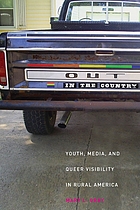Last week I reviewed Sarah Schulman's Ties That Bind which explored from a very personal perspective the ravages of familial homobigotry. This week I picked up and read Mary L. Gray's Out in the Country: Youth, Media, and Queer Visibility in Rural America (New York University Press, 2009). Gray's ethnographic study of queer teen lives in rural Kentucky took place in the early 2000s and she published her book in the same year as Schulman. Both authors write thoughtfully about the importance of family in the lives of their queer subjects -- though from very different perspectives. Ironically -- given our usual narrative of urban tolerance vs. rural bigotry -- Gray's consideration of the place of family within queer lives is much more nuanced than Schulman's.
As a researcher, Gray came from a rural California childhood followed by an urban California adulthood working with queer youth organizations. Her exploration of teen lives in rural Kentucky was prompted by national attention on the ways in which the Internet and other media connectivity and queer visibility might work differently in the lives of rural young people rather than urban young people. As she (and others before her) have pointed out, much of our understanding of queer coming-of-age posits a rural-to-urban migration in which our queer selves are incapable of being fully discovered and/or nourished until we "escape" our hometown settings and find the LGBT community in physical locales -- gay bars, lesbian bookstores, gay ghettos, queer action groups. Pushing back against this assumption, Gray sought out youth who were either unable or uninterested in making such a migratory journey of self-discovery. How would young queer people without the resources or desire to leave rural life for the city construct a queer identity?
In Ties That Bind, urban-based adult writer Schulman struggles with familial rejection in the face of her queer activism and chosen family of fellow lesbian, gay, and other non-straight friends. Ties is firmly situation in the milieu of Gay New York, a landscape we all (at least think we) know well, and situates its lesbian protagonist (Schulman) as an adult who struggles to connect with her parents and siblings, but as an adult dragging them to therapy appointments or participating (or not) in rituals like the weddings of relatives. Schulman's pain is that of an adult attempting to reconcile with the failures of her parents' parenting.
In contrast, Gray explores the dense interconnectivity necessary for survival in isolated rural settings. Families of origin, she argues, make or break the experience of rural queer folk in communities where the familiar is often the key to acceptance. Straight family members can act as brokers for their queer youths -- turning the queer into the familiar, making one of "them" into one of "us". The most resilient teens whom Gray encountered were typically youths whose parents supported their identity explorations and attempts to build broader support networks: paying for internet or access to health services, driving them long distances to regional meet-ups, participating in protest actions, or other acts which communicated to fellow townsfolk that their child was not to be disavowed. The more vulnerable children were those whose families either could not or would not provide such support -- in part because, unlike urban queer adults, these youths could not take the city bus to the "gay" district or surreptitiously visit the "women's" bookstore.
In some ways Gray's work underscores the central point that Schulman makes: that queer family members can't just disown their families of origin -- no matter how anti-gay those families are -- and replace them with chosen families without consequence. For Schulman, those consequences are mostly emotional and psychological: the pain of rejection, the loss of future relationship. For Gray's teens, in addition to the emotional support (or pain) a family can provide (or cause) for their queer members in a hostile culture, families are also the gateway to material resources and community belonging. The visibility of queer culture in the media, and access to information -- plus the ability to connect to far-flung networks -- that the Internet provides cannot replace, for queer youth, the insulation that local relationships provide. Nor does an urban-oriented narrative of queerness reliably serve these young people as they work to create usable identities for themselves and their communities.
This was a useful read, one which I might pair with Pray the Gay Away (also about queer folk in the Bible Belt around Louisville, Kentucky) and Not in This Family (challenging the narrative of universal familial rejection of queer family members in postwar America).

No comments:
Post a Comment